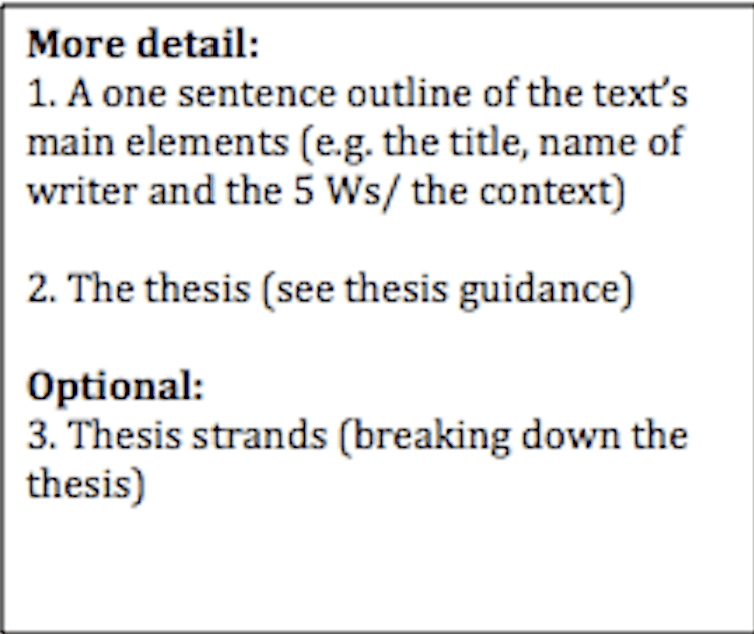What’s an introduction for?
The introduction should lay the foundations for what follows, by:
Mentioning the title, creator, and text type
Putting the text in context
Outlining the main ‘events‘ of the text
Stating your main interpretation: the thesis

An Introduction Example (broken up):
Relevant elements and context summarised:
In his poem ‘Refugee Blues’, W.H. Auden presents the perspective of a German Jew in Europe shortly before the Second World War, addressing his loved one about their persecution by the Nazis.
Thesis statement:
Auden uses this intimate perspective and a Blues-like form to elicit our sympathy and outrage towards the unjust, dehumanising treatment of the Jewish people.
Thesis strands (optional):
His use of the musical form creates parallels between slavery and the situation of the Jews in Europe. He also uses nature imagery to convey how the Jews were treated as less than human or even animal, and throughout the poem reveals how they were not only forced out of their homes but also refused refuge by others.



So good introductions briefly contextualize, summarise and announce the text and interpretation to be argued. Everything that follows should connect back to the introduction.
What has this introduction done?

Contextualised the poem
Summarised the main literal elements
Offered two thesis strands. (claims about specific aspects or parts of the poem)
Made good use of precise verbs and evaluative adjectives to show the impact of the poem
Clearly focused on the question…it’s definitely looking at different types of suffering and how they are shown by the poet.

Keeping the question in mind, look at how the introduction continues with a third thesis strand above
and builds to an overarching claim – an interpretation of the poem’s meaning as a whole – the thesis statement…
Another example introduction:
In this dark and suspenseful passage from the opening (placement in context) of The War of the Worlds (The work being discussed), H.G. Wells (Author) presents a coolly distant narrator describing the way in which humans continue to go about their simple lives whilst unaware of an attack being planned against them by an alien species (Literal summary). Wells uses this passage to represent the dangers of human ignorance and arrogance by challenging our knowledge of the universe and the assumption that we are a superior species (Thesis statement).
…and optional thesis strands:
He firstly establishes the naïve skepticism of the human race about the possibility of there being worlds outside our own by mocking some of the common early beliefs about space and the universe (thesis strand 1).He also reveals the vulnerability of mankind as a result of arrogance, by showing the aliens to be terrifyingly cold, calculating and ruthless in the way that they plan their attack (thesis strand 2). However, Wells also suggests that the aliens might also be misguided by their own pride and disdain for other species by hinting at the failure of their imminent attack, showing the universal folly of self-importance. (thesis strand 3)
What about introductions to non-fiction texts?
It’s especially important to put non-fiction texts in context by identifying text type, purpose and audience in the introduction.
On the right is a short color-coded introduction that contextualizes a passage (Context, Audience, Purpose) and offers a thesis in response to the question: How does the writer use stories to show the effects of war?
In this extract from ‘A Passage to Africa’, George Alagiah tells the disturbing and emotive stories of individuals suffering from the effects of war in Somalia, painting graphic pictures of individuals who died and survived for a Western audience that does not live in such circumstances. More interesting again is the way he tells his own story in this memoir, reflecting on the desensitizing effects of his experiences as a journalist in an unsettlingly frank manner. However, he builds up to an encounter that deeply moved and changed him, reminding him and us of the humanity of those people we see and read of in news stories.
